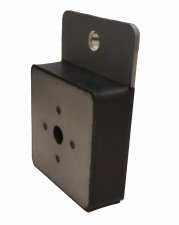Rubber Vibration Isolators
Rubber vibration isolators play a crucial role in controlling vibrations, reducing noise levels, and preserving the integrity of structures and equipment across various industries. With their ability to absorb and dissipate mechanical energy, they help increase tthe efficiency of vibratory equipment and help prolong the lifespan of machinery.
In an automation system, rubber vibration isolators have multiple applications. They are used as footl locators for feeder base units and as vibration dampeners for pan hoppers. Foot Locators are metal plates with a round hole sized to accept the feeder base unit's rubber feet. One end of the plate has a slot through which a bolt provides an adjustable but secure way of attaching the locator to the feeder mounting surface. The foot locators 'lock' the feeder into place and prevent it from shifting out of place. In a pan hopper rubber vibration isolators help with the controlled distrubution of parts from the hopper.
Title: Rubber Vibration Isolators: An Essential Solution for Noise and Vibration Control
Introduction: In a world where noise pollution and unwanted vibrations are increasingly common, finding effective solutions to mitigate their impact has become crucial. Whether it's in industrial settings, automotive applications, or even household appliances, controlling vibrations and reducing noise is essential for ensuring smooth operations, increasing comfort, and preserving the longevity of equipment. Among the various methods available, rubber vibration isolators have emerged as a reliable and versatile solution. In this blog post, we will explore the functionality, benefits, and applications of rubber vibration isolators.
Understanding Rubber Vibration Isolators: Rubber vibration isolators, also known as rubber mounts or dampeners, are devices designed to minimize the transmission of vibrations and noise between two surfaces or components. They are typically made from high-quality rubber compounds, such as neoprene or natural rubber, chosen for their excellent elasticity, durability, and resistance to environmental factors.
How Rubber Vibration Isolators Work: Rubber vibration isolators function based on the principle of vibration isolation, which involves the absorption and dissipation of mechanical energy. The isolators are strategically placed between the vibrating source and the structure or equipment it is mounted on. When vibrations are generated, the rubber isolators absorb the energy and convert it into heat, effectively reducing the amplitude and intensity of vibrations transmitted to the surrounding environment.
Benefits of Rubber Vibration Isolators:
-
Vibration Control: Rubber isolators act as a barrier, effectively reducing vibrations transmitted through mechanical equipment, engines, or other sources. By minimizing vibrations, they help prevent structural damage, equipment failure, and unnecessary wear and tear.
-
Noise Reduction: Vibrations often produce noise as a byproduct. Rubber vibration isolators dampen these vibrations, thereby reducing noise levels. This benefit is particularly relevant in applications where noise reduction is critical, such as HVAC systems, generators, or industrial machinery.
-
Equipment Longevity: The ability of rubber isolators to absorb shocks and vibrations enhances the lifespan of equipment. By minimizing stress and strain on components, they prevent premature failure, maintenance issues, and costly repairs.
-
Enhanced Stability: Rubber vibration isolators improve the stability and balance of machinery or structures by reducing excessive movement caused by vibrations. This leads to better performance, improved accuracy, and increased safety.
Applications of Rubber Vibration Isolators: The versatility of rubber vibration isolators makes them suitable for various industries and applications, including:
-
Industrial Machinery: Rubber isolators are commonly used in automation systems to control the vibration of drive units and pan hoppers . They can also be found in heavy machinery, such as compressors, pumps, and generators, to minimize vibrations and reduce noise levels in industrial environments.
-
Automotive: In automobiles, rubber vibration isolators are employed in engines, exhaust systems, suspension components, and chassis mounts. They help isolate vibrations, reduce noise, and enhance overall ride quality.
-
HVAC Systems: Heating, ventilation, and air conditioning (HVAC) systems rely on rubber vibration isolators to minimize vibrations and noise generated by the compressor, fan motors, and other components.
-
Electronic Equipment: Computers, servers, electronic enclosures, and sensitive laboratory equipment often employ rubber isolators to minimize vibrations that can interfere with their performance or accuracy.
Conatct sales@autodev.com or call us at 814-474-5561 for more information and pricing on our rubber vibration isolators


